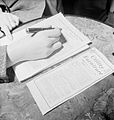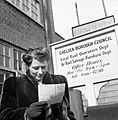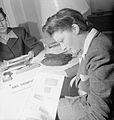Utility furniture
This article needs additional citations for verification. (March 2014) |
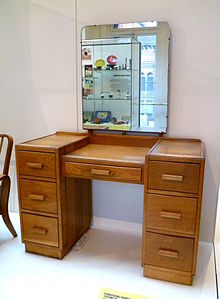
Utility furniture was furniture produced in the United Kingdom during and directly after World War II. The furniture was produced under a government scheme which was designed to cope with raw material shortages and rationing of their usage. Introduced at the end of 1942, the Utility Furniture Scheme continued into post-war austerity and lasted until its abolition in March 1949.[1]
Background
[edit]By 1941, there was a lack of timber suitable for furniture making.[citation needed] This, combined with losses caused by bombing and the establishment of many new households, had created a severe furniture shortage.
The Utility Furniture Advisory Committee
[edit]
The Utility Furniture Advisory Committee was set up in 1942[2] in order to assure that the available resources were used efficiently. It drew on expertise from Gordon Russell, Edwin Clinch, Herman Lebus and John Gloag. Among the committee's other members was Charles Jenkinson, a Leeds vicar and social reformer.[3]
New furniture was rationed and was restricted to newlyweds and people who had been bombed, under the "Domestic Furniture (Control of Manufacture and Supply (No 2)) Order 1942" operative from 1 November 1942.
The same logo was used for utility furniture as for utility clothing: two capital 'C's and the figure 41.
Utility Furniture Catalogue
[edit]The committee produced approved designs that were published in the Utility Furniture Catalogue of 1943[4]. The aim was to ensure the production of strong, well-designed furniture which made efficient use of timber. The Arts and Crafts movement influenced the designs, which were considered to be simplistic due to their lack of decoration (which was contrary to the popular taste of the immediate pre-war period). Furniture based on these designs was constructed by a number of firms around the country - 589 in January 1946, increasing to 1729 in January 1949[5].

The committee was reformed as the Utility Design Panel in 1943 with Gordon Russell as chairman.[6] In 1946 the panel unveiled three new furniture ranges (Cotswold, Chiltern and Cockaigne), intending to display their post-war design ethos at the "Britain Can Make It" exhibition.
Demise
[edit]The panel were believers in the aesthetic quality of their designs. However, demand for ornamentation arose, and there were instances of black market utility furniture with added decoration.[citation needed] Design rules were relaxed in 1948 and the "Diversified" range, which drew from contemporary Scandinavian designs, was announced. However, the tide of public taste was against it and the panel was wound down. The scheme was officially closed in 1952, the same year that furniture rationing ceased.
Gallery
[edit]-
Living room furniture at the Utility Furniture Exhibition, The Building Centre, London, 1942.
-
Bedroom furniture at the same exhibition.
-
Applying for a "Household Buying Permit".
-
Receiving the permit.
-
Making the purchase from a catalogue of utility furniture.
References
[edit]- ^ "Board of Trade: Utility Furniture Scheme: Files". The National Archives. The National Archives (United Kingdom). Retrieved 25 September 2024.
- ^ Fiell, Charlotte; Fiell, Peter (2005). Design of the 20th Century (25th anniversary ed.). Köln: Taschen. p. 701. ISBN 9783822840788. OCLC 809539744.
- ^ Hargreaves, John A. (2004). "Jenkinson, Charles (1887–1949)". Oxford Dictionary of National Biography. Oxford Dictionary of National Biography (online ed.). Oxford: Oxford University Press. doi:10.1093/ref:odnb/65624. (Subscription or UK public library membership required.)
- ^ "CC41 Utility Furniture Catalogue". The Internet Archive. Retrieved 25 September 2024.
- ^ "Utility Furniture: HC Deb 15 February 1949 vol 461 c148W". Hansard 1803–2005. Hansard. Retrieved 25 September 2024.
- ^ Woodham, Jonathan M. (1997). Twentieth-Century Design. Oxford: Oxford University Press. p. 118. ISBN 978-0-19-284204-6.
Further reading
[edit]- Sword, Richard (1974). Utility furniture and fashion, 1941–1951. ISBN 0-7168-0628-2.
- Mills, Jon (2008). Utility Furniture - The 1943 Utility Furniture Catalogue with an explanation of Britain's Second World War Utility Furniture Scheme. ISBN 978-0-9552723-2-5.
- Reimer, Suzanne; Pinch, Philip (January 2013). "Geographies of the British government's wartime Utility furniture scheme, 1940–1945". Journal of Historical Geography (39): 99–112. doi:10.1016/j.jhg.2012.07.003. Retrieved 25 September 2024.

